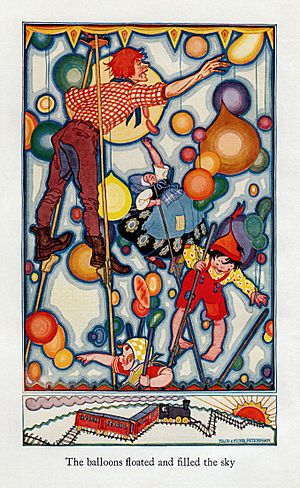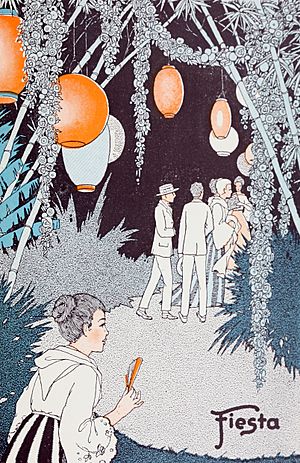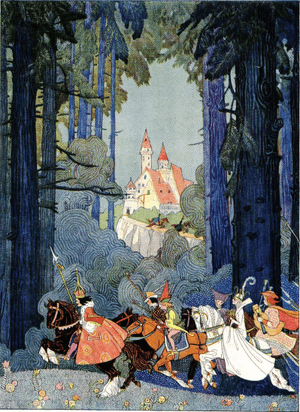Maud and Miska Petersham facts for kids

Maud Fuller Petersham (born August 5, 1890 – died November 29, 1971) and Miska Petersham (born September 20, 1888 – died May 15, 1960) were American writers and illustrators. They helped shape how illustrated children's books look today. The Petershams worked closely with important children's book editors and printers. They worked together as a team for over 50 years. They illustrated more than 120 books, including textbooks and picture books. They also wrote and illustrated 50 of their own books. Many of these books won important awards. They were known for their beautiful art, bright colors, and for sharing stories from different cultures.
Contents
Early Lives and Meeting
Maud Fuller was born on August 5, 1890, in Kingston, New York. Her family had lived in America for many generations. Her mother's family were Quakers from Rhode Island. Her father was a Baptist minister, and his family moved several times. Maud was the third of four daughters. She graduated from Vassar College in 1912. Later, she studied art at the New York School of Fine and Applied Art. She met Miska Petersham while working at a design company called International Art Service (IAS) in New York City.
Miska was born Petrezselyem Mihaly in Torokszentmiklos, Hungary, on September 20, 1888. His father was a carpenter and blacksmith. Miska studied art at the Royal National School for Applied Arts in Budapest. He finished his studies in 1911. He then moved to London and, six months later, traveled to New York. He arrived through Ellis Island in 1912. He quickly found work at the International Art Service, the same art studio where Maud worked.
Starting Their Career Together
Maud and Miska met while working at the IAS studios. They got married three years later in 1917. They moved to Greenwich Village in New York City. They got their first job illustrating a children's book through Miska's friend, Willy Pogany. He was already a well-known illustrator. Within a few years, they had many illustration jobs. May Massee, an editor at Doubleday, greatly supported their work.
By 1923, they were doing well enough to buy land. They built a house in Woodstock, New York. This area was near the active Byrdcliffe Arts and Crafts Colony. During this time, they illustrated many books. Some of these included A Child's Own Book of Verse and Carl Sandburg's Rootabaga Stories. They also illustrated Margery Clark's The Poppyseed Cakes and Johanna Spyri's Heidi.
The first book they both wrote and illustrated was Miki. It was about their son and was published in 1929. Maud later explained why they started writing their own books. She said, "At first we illustrated books written by others. But often we found no place in the text that lent itself to illustration. So we decided to plan a book of our own with both pictures and text."
Awards and Recognition
The Petershams' work was recognized by the American Institute of Graphic Arts (AIGA). Four of their books were chosen for special AIGA exhibitions. These were Nursery Friends from France, Children of the Mountain Eagle, Tales Told in Holland, and Get-A-Way and Háry János.
In 1937, the American Library Association started the annual Caldecott Medal. This award is for the best children's picture book. The Petershams were runners-up for their book An American ABC in 1942. They won the Caldecott Medal in 1946. Today, they are perhaps best known for that winning book. It was called The Rooster Crows (Macmillan, 1945). This book was a collection of American songs, rhymes, and games.
The Petershams had two children, a son named Miki and a daughter named Elizabeth.

Books Written and Illustrated by the Petershams
Here are some of the books that Maud and Miska Petersham both wrote and illustrated:
- Tales from Shakespeare by Charles Lamb and Mary Lamb (1923)
- The Billy Bang Book by Mabel Guinnip La Rue (1927)
- Miki: The Book of Maud and Miska Petersham (1929)
- The Ark of Father Noah and Mother Noah (1930)
- The Christ Child (1931)
- Auntie and Celia Jane and Miki (1932)
- Get-A-Way and Háry János (1933)
- The Story Book of Things We Use: Houses, Clothes, Food, Transportation (1933)
- Miki and Mary: Their Search for Treasures (1934)
- The Story Book of Earth’s Treasures: Gold, Coal, Oil, Iron and Steel (1935)
- The Story Book of Wheels, Ships, Trains, Aircraft (1935)
- The Story Book of Foods from the Fields: Wheat, Corn, Rice, Sugar (1936)
- David: From the Story Told in the First Book of Samuel and the First Book of Kings (1938)
- Joseph and His Brothers (1938)
- Moses: From the Story Told in the Old Testament (1938)
- Ruth: From the Story Told in the Old Testament (1938)
- Stories from the Old Testament (1938)
- The Story Book of Things We Wear: Wool, Cotton, Silk, Rayon (1939)
- An American ABC (1941)
- Story of Jesus (1942)
- The Rooster Crows: A Book of American Rhymes and Jingles (1945)
- America’s Stamps: The Story of One Hundred Years of U.S. Postage Stamps (1947)
- My Very First Book (1948)
- The Box with Red Wheels (1949)
- The Circus Baby (1950)
- A Bird in the Hand: Sayings from Poor Richard’s Almanac (1951)
- Story of the Presidents of the United States of America (1953)
- Off to Bed: 7 Stories for Wide-Awakes (1954)
- The Boy Who Had No Heart (1955)
- The Silver Mace: A Story of Williamsburg (1956)
- The Peppernuts (1958)
- The Shepherd Psalm: Psalm XXIII from the Book of Psalms (Maud Petersham alone; 1962)
Images for kids





